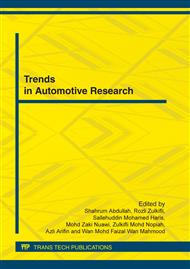p.290
p.295
p.300
p.305
p.310
p.316
p.323
p.330
p.334
Evaluation of Different Control Policies of Semi-Active MR Fluid Damper of a Quarter-Car Model
Abstract:
Proportional Integral Derivative and clipped-optimal control strategy controllers are studied to control the response of Quarter-car suspension profile. A Semi-active device is used for this purpose because it carries valuable result which maintains the reliability of passive control methods and includes the advantage of the adjustable parameter characteristics of active systems. Semi-active devices like Magnetorheological fluids dampers are very effective to control vibration, which use MR fluids to produce controllable damping force and provide both the reliability of passive systems and the facility of active control systems with small power supply. The quarter car model is used here can be described as a nonlinear two degrees of freedom system which is subject to excitation from different road profile. For the best possible reduction of vibration in suspension systems, various Magnetorheological damper models are studied which Bouc-wen model, Neuro-fuzzy model and Bingham model. The performances of these models are evaluated to select a best model. The quarter-car model is executed using step input with two most common and effective control algorithm in vehicle suspension control which are linear quadratic regulator control, and Proportional Integral Derivative control algorithm. The main objective of this study is to evaluate performances of these control algorithms.
Info:
Periodical:
Pages:
310-315
Citation:
Online since:
April 2012
Price:
Сopyright:
© 2012 Trans Tech Publications Ltd. All Rights Reserved
Share:
Citation:


